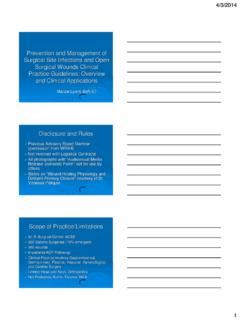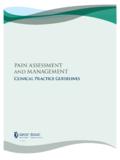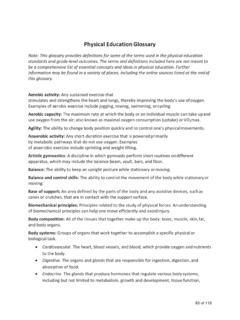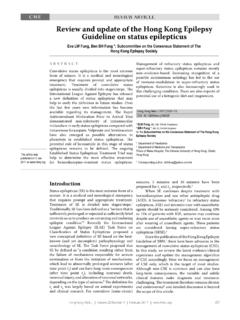Transcription of NEONATAL CLINICAL HSC # 80.275.552 PRACTICE GUIDELINE
1 Title: Management of cardiorespiratory Events in Newborns Approval Date: Pages: March 2015 1 of 5. Approved by: Supercedes: NEONATAL CLINICAL NEONATAL Patient Care Teams, HSC & SBH HSC # PRACTICE GUIDELINE Child Health Standards Committee SBH #108. PURPOSE AND INTENT. To provide a process for management, monitoring, treatment and documentation of cardiorespiratory events including apnea, bradycardia and desaturations in premature infants in NEONATAL units who do not require respiratory support. To provide for safe, effective and consistent use of caffeine to treat apnea of prematurity. Note: All recommendations are approximate guidelines only and practitioners must take in to account individual patient characteristics and situation.
2 Concerns regarding appropriate treatment must be discussed with the attending neonatologist. PRACTICE OUTCOME. Prevent and minimize the potential long term neurodevelopmental impact of these events. DEFINITIONS. Apnea (clinically significant): A respiratory pause greater than or equal to 20 seconds or any respiratory pause associated with oxygen desaturation and/or bradycardia. Apnea of Prematurity: Condition characterized by episodes of apnea in infants generally with a post- menstrual age less than 37 weeks in the absence of any other condition that may cause apnea ( sepsis). Periodic Breathing: A series of 3 or more respiratory pauses per minute longer than 3 seconds with intervals of respiration between pauses. This pattern of breathing is common in newborns and is usually not associated with significant bradycardia or desaturation.
3 Gestational Age (GA) (completed weeks, not rounded up): Time elapsed between the first day of the last menstrual period and the day of delivery. If pregnancy was achieved using assisted reproductive technology, gestational age is calculated by adding 2 weeks to the conceptual age. Chronological Age (days, weeks, months, or years): Time elapsed since birth. Postmenstrual Age (PMA): Gestational age plus chronological age. This is the preferred term to use during the perinatal NEONATAL hospital stay. Preterm: A preterm (premature) infant is one born at a gestational age of 259 days (37 weeks) or less. Methylxanthines: Methylated derivatives of xanthine, including caffeine, theobromine and theophylline that serve as a smooth muscle relaxant and cardiac muscle and central nervous system stimulant.
4 Respiratory Support: An artificial means of mechanical support which includes: intubation, tracheostomy, nCPAP (nasal continuous positive airway pressure) or non-invasive ventilation, an oral or nasal airway or low flow oxygen ( nasal prongs) (regardless of oxygen level). Bradycardia: A heart rate less than 100 beats per minute in infants less than or equal to 1250 grams (present weight) and less than 80 beats per minute in term infants or premature infants with current weight greater than1250 grams. Management of cardiorespiratory Events in Newborns Page 2 OF 5. Desaturation: Oygen saturation (SpO2 ) less than 85% unless otherwise specified in physician's/NNP's order. Positive Pressure Ventilation (PPV): the application of positive pressure using a self-inflating or flow inflating anaesthesia bag through a full-face mask encompassing the nose and mouth.
5 Self-Resolved Event: Infant began spontaneous respiration and showed oxygen saturation recovery without any intervention. Mild Event: Infant began spontaneous respiration and showed oxygen saturation recovery within 10. seconds of minimal tactile stimulation, such as gentle touch. Moderate Event: Infant began spontaneous respiration and showed oxygen saturation recovery within 30 seconds of the beginning of the event with moderate tactile stimulation, such as gently rubbing the back, trunk or extremities, and/or flicking soles of the feet. Severe Event: Infant did not show respiratory and oxygen saturation recovery within 30 seconds of the beginning of the event in spite of moderate tactile stimulation as described above and required positive pressure ventilation.
6 guidelines . General Management Provide cardiorespiratory monitoring to all infants who are less than 35 weeks 0 days gestation after birth until risk for developing apnea of prematurity is assessed, usually for at least 72. hours or until 34 weeks and 6 days - post-menstrual age, whichever comes first. Continue cardiorespiratory monitoring for up to 3 days after the last documented cardiorespiratory episode. It is up to the discretion of the attending Neonatologist to determine the significance of the events and the duration of monitoring. If the infant has frequent cardiorespiratory episodes conduct a full CLINICAL examination including assessment of airway patency, thermal stability, blood pressure, glucose regulation and other potential causes of apnea.
7 Set physiologic monitor with a 20-second apnea delay. Consider treatment with methylxanthine medications (see section below) or CPAP. Set the oxygen concentration on the blender connected to a bag (flow-inflating or selfinflating) to be equal to the oxygen level that the infant is generally receiving. The attending neonatologist evaluates discharge criteria on a case by case basis. CLINICAL situations may vary particularly in regards to: Significance of apnea or bradycardia that is an isolated event. Significance of apnea that is associated with feeding. Weaning of caffeine in hospital or plan for discharge management of caffeine. Consider a control of breathing study in infants meeting ALL the following inclusion criteria: Corrected post conceptional age greater than 35 weeks 6 days.
8 Feeding ad lib demand. Having persistent apneas, bradycardias, and/or desaturations at rest. Not on caffeine maintenance. No other medical condition keeping the infant from being discharged home. Management of cardiorespiratory Events in Newborns Page 3 OF 5. If an immature breathing pattern is recognized during the sleep study that significantly improves with a loading dose of caffeine, consider discharge home on caffeine after a few days of observation in the unit at the discretion of the neonatologist. Management of Events When the monitor alarms, evaluate the infant for airway patency, respiratory movements, color, and heart rate. Assess the infant for hyperextension or flexion of the neck. Reposition the head and neck if necessary.
9 Maintain the head and neck in a neutral position. If the infant continues to be apneic or bradycardic after the quick assessment and position change, initiate appropriate tactile stimulation. If the infant continues to have inadequate respiratory effort after 30 seconds from the beginning of the event, discontinue stimulation and administer positive pressure ventilation (PPV). If the infant has some respiratory effort, provide only Positive End Expiratory Pressure (PEEP) of 5-6 cmH2O. If the infant shows no respiratory effort, provide breaths at a rate of 30-60 per minute. Avoid hyperventilation as this may decrease the infant's PCO2 level and suppress the stimulus to breathe. Administering free-flow oxygen or continuing to provide tactile stimulation to an apneic or bradycardic infant wastes valuable time.
10 Reassess respiratory effort, heart rate and oxygen saturation after 60-90 seconds of PPV. if it is required for that length of time. Increase the inspired oxygen (FiO2 ) only if the baby's color, heart rate and oxygen saturation do not show any improvement at this point. Continue PPV until regular respiration, normal heart rate and colour have returned to baseline. Document on the NEONATAL cardiorespiratory Events Record: Any respiratory pause that is greater than 20 seconds or has an associated bradycardia or desaturation not caused by care/interventions(suctioning or gastric tube insertion). The duration of the episode from the time that the monitor indicates the episode began (using the events record or Oxycrg feature) until the episode resolves.














